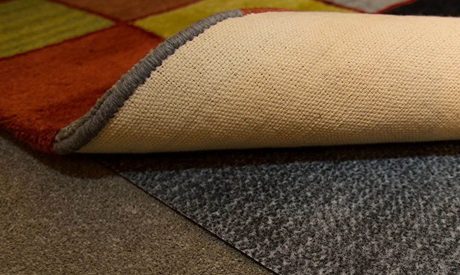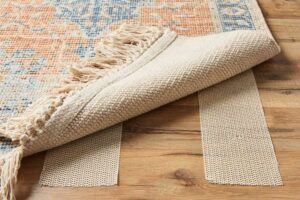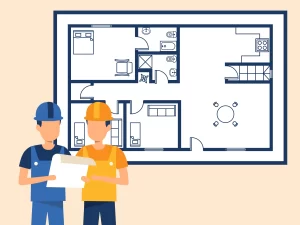
Securing Style: Preventing Rug Slippage on Carpeted Floors
Introduction
Area rugs can add warmth, comfort, and style to a room, but keeping them in place on carpeted floors can be a challenge. The constant shifting and sliding of rugs not only disrupt the aesthetics but also pose safety concerns. In this comprehensive guide, we’ll explore effective ways to keep a rug from sliding on carpet, providing solutions that range from simple fixes to more specialized products.
Understanding the Challenge
Rugs on carpeted floors often struggle to maintain their position due to the smooth surface beneath them. The lack of friction can lead to annoying slipping and sliding, creating an inconvenience for homeowners. However, with the right strategies and products, you can ensure that your rugs stay securely in place.
Preventing Rug Slippage: Practical Solutions
1. Double-Sided Rug Tape or Grippers
a. Double-Sided Tape:
- Use double-sided rug tape to secure the edges of the rug to the carpet. Ensure the tape is designed for rug-to-carpet applications for optimal adhesion.
b. Rug Grippers:
- Rug grippers, which resemble pads with adhesive on both sides, can be placed under the corners or edges of the rug to prevent sliding.
2. Velcro Strips or Velcro Rug Pads
a. Velcro Strips:
- Attach Velcro strips to the underside of the rug and corresponding strips to the carpet. The Velcro connection adds stability.
b. Velcro Rug Pads:
- Invest in rug pads with Velcro on both sides. This creates a secure bond between the rug and the carpet, minimizing slippage.
3. Non-Slip Rug Pads
a. Rubber or Latex Backing:
- Choose rug pads with rubber or latex backing, as these materials provide excellent grip on carpeted surfaces.
b. Mesh or Waffle Design:
- Opt for rug pads with a mesh or waffle design, as the pattern enhances friction and prevents sliding.
4. Heavy Furniture or Decor Items
a. Strategically Placed Furniture:
- Position heavy furniture or decor items strategically on the edges or corners of the rug to anchor it in place.
b. Bookshelves or Cabinets:
- If applicable, place bookshelves or cabinets on the rug to provide additional weight and stability.
5. Rug Corners and Weights
a. Curling Rug Corners:
- Use adhesive Velcro strips or double-sided tape specifically designed for rug corners to prevent curling and sliding.
b. Weighted Corners:
- Place decorative weights or clips on the corners of the rug to anchor them securely to the carpet.
6. Carpet-to-Carpet Rug Pads
a. Dual-Surface Texture:
- Invest in rug pads designed for carpet-to-carpet use. These pads typically feature a dual-surface texture that enhances grip.
b. Thicker Padding:
- Choose rug pads with thicker padding, as they provide more friction and help prevent rug slippage.
7. Caulk or Silicone Caulk Application
a. Underside of the Rug:
- Apply lines of caulk or silicone caulk to the underside of the rug in a grid pattern. Allow it to dry completely before placing the rug on the carpet.
b. Flexible and Durable:
- Caulk creates a flexible and durable surface that grips the carpet, preventing the rug from sliding.
8. DIY Rug Underlay Using Carpet Tape and Fabric
a. Carpet Tape Strips:
- Attach carpet tape strips to the underside of the rug.
b. Fabric Overlay:
- Place a thin fabric overlay on top of the tape to add friction and protect the carpet.
9. Rubber Shelf Liner or Drawer Liner
a. Cut-to-Size Pieces:
- Cut rubber shelf liner or drawer liner into pieces and place them strategically under the rug. The textured surface enhances grip.
b. Easily Removable:
- Rubber liners are easily removable and do not damage the carpet, making them a versatile option.
10. Regular Cleaning and Maintenance
a. Vacuuming and Shaking:
- Regularly vacuum both the rug and the carpet to remove dust and debris that may reduce friction.
b. Inspect Rug Pads:
- Periodically inspect and clean rug pads to ensure they maintain their non-slip properties.
Frequently Asked Questions:
Q1: Can I use regular carpet tape on rugs?
A1: Regular carpet tape is designed for permanent adhesion and may damage the rug or carpet. It’s recommended to use rug-specific double-sided tape for temporary applications.
Q2: Do rug grippers damage the carpet?
A2: High-quality rug grippers are designed to be gentle on carpets. However, it’s essential to choose grippers with safe adhesives to avoid any potential damage.
Q3: How do I remove rug tape residue from the carpet?
A3: Use a gentle adhesive remover or rubbing alcohol on a clean cloth to dab and lift away any tape residue. Test in an inconspicuous area first to ensure compatibility.
Q4: Can I use rug pads on all types of rugs?
A4: Yes, rug pads are suitable for various types of rugs, including area rugs, runners, and oriental rugs. Ensure the rug pad is appropriate for use on carpets.
Q5: Can I use furniture alone to keep the rug in place?
A5: While strategically placed heavy furniture can help anchor a rug, it may not be sufficient on its own, especially for smaller or lightweight rugs.
Q6: Are rubber-backed rugs effective in preventing slippage?
A6: Rubber-backed rugs can provide some grip on carpets, but they may not be as effective as using non-slip rug pads for larger area rugs.
Q7: Can I use carpet tape for the entire rug?
A7: It’s not recommended to use carpet tape for the entire rug, especially if you want to preserve the carpet underneath. Opt for methods like rug pads or grippers for a more suitable solution.
Q8: Do rug pads work on hardwood floors as well?
A8: Yes, many rug pads are versatile and suitable for use on hardwood floors. Check the product specifications to ensure compatibility with your flooring type.
Q9: Can I cut a rug pad to fit my rug size?
A9: Yes, most rug pads can be easily cut to fit the specific size of your rug. Use scissors or a utility knife to trim the pad to the desired dimensions.
Q10: How often should I check and clean rug pads?
A10: It’s advisable to check and clean rug pads at least twice a year. Regular inspection ensures that the pad maintains its non-slip properties and does not transfer any debris to the carpet.
Conclusion
Safeguarding your rugs from slipping on carpeted floors involves a combination of practical solutions and preventive measures. Whether you opt for rug tape, non-slip pads, or DIY methods, the key is to create a stable foundation that enhances both safety and aesthetics. Experiment with different approaches to find the combination that works best for your specific rugs and carpeted areas. With the right strategies in place, you can enjoy the comfort and style of your rugs without the inconvenience of constant slippage.


